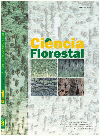
|
Ciência Florestal
Centro de Pesquisas Florestais - CEPEF, Departamento de Ciências Florestais - DCFL, Programa de Pós Graduação em Engenharia Florestal - PPGEF
ISSN: 0103-9954
EISSN: 0103-9954
Vol. 18, No. 4, 2008, pp. 511-523
|
 Bioline Code: cf08048
Bioline Code: cf08048
Full paper language: Portuguese
Document type: Research Article
Document available free of charge
|
|
|
Ciência Florestal, Vol. 18, No. 4, 2008, pp. 511-523
| en |
Data ordination of Mixed Rain Forest structure based on information of floristic forest inventory of Santa Catarina state, southern Brazil: results of a pilot survey
Vibrans, Alexander Christian; Uhlmann, Alexandre; Sevegnani, Lucia; Marcolin, Moacir; Nakajima, Nelson; Grippa, Carlos Roberto; Brogni, Eduardo & Godoy, Marcela Braga
Abstract
The floristic forest inventory of Santa Catarina State in Southern Brazil aims at quantifying the
forest resources and increasing the knowledge on vascular plant diversity. The study includes sampling of
trees, shrubs, herbs and vascular epiphytes. Santa Catarina State's surface is about 95,443 km², covered by
four major vegetation types: Dense Tropical Humid Forests, Mixed Rainy Forests with Araucaria
angustifolia, highland grasslands and Seasonal Deciduous Forests. Forest land cover is about 30%, although
extremely fragmentized, especially in the western region. This pilot study has been conducted in Mixed
Rainy Forest domain during 2005, measuring 74 sample plots (2000 m² each) randomly distributed in this
forest type's area (41,380 km²). Besides the usual analysis of vertical and horizontal vegetation structure,
species density data were utilized to construct species/samples matrix that was the basis for Detrended
Correspondence Analysis (DCA). The survey results indicate that Myrtaceae, Fabaceae, Lauraceae are the
most numerous families, followed by Asteraceae and Solanaceae. The survey registered 133 species with DBH ≥ 10cm, 101 species with DBH <10cm ≥1cm and 105 species with DBH smaller than 1 cm. There is a
restricted number of very frequent tree species and a large number (120) of species occurring in less than 10
of the total of 74 sample plots; 46 species are present in only one plot, showing vulnerability of species
diversity. According to results of Correspondence Analysis, there are two well distinguished clusters of plots,
one of them dominated by typical mixed forest species; the other cluster clearly dominated by supposed to be
typical seasonal deciduous forest representants, although located in geographical region until now attributed
to mixed forests. The two groups are very dissimilar with respect to their structure and floristics. These
results indicate the necessity of new surveys in order to verify the existence of a floristic differentiation along
this preliminary established border line. The next steps of Floristic-Forest Inventory could give way to
support this hypothesis.
Keywords
floristics; correspondence analysis; Mixed Rainy Forest; forest inventory
|
| |
| pt |
Ordenação dos dados de estrutura da Floresta Ombrófila Mista partindo de informações do inventário florístico-florestal de Santa Catarina: resultados de estudo-piloto
Vibrans, Alexander Christian; Uhlmann, Alexandre; Sevegnani, Lucia; Marcolin, Moacir; Nakajima, Nelson; Grippa, Carlos Roberto; Brogni, Eduardo & Godoy, Marcela Braga
Resumo
O Inventário Florístico-Florestal do Estado de Santa Catarina tem por objetivo inventariar e analisar
a composição florística e a estrutura horizontal e vertical dos remanescentes florestais do Estado, registrar a
diversidade arbórea das florestas e coletar dados sobre as espécies vegetais ameaçadas de extinção. A
cobertura florestal de seu território de 95.443 km² é inferior a 30%, porém, extremamente reduzida e
fragmentada na sua região oeste do estado. Nesse estudo-piloto, foram implantadas 74 unidades amostrais de
2000 m² cada, distribuídas aleatoriamente numa área de 41.380 km² nos domínios da Floresta Ombrófila
Mista. Além da análise usual da estrutura horizontal e vertical, os dados de densidade foram utilizados para a
construção de uma matriz de densidades (espécie/parcela) que foi submetida à Análise de Correspondência
Corrigida (ACC). Os resultados do levantamento indicam Myrtaceae, Lauraceae e Fabaceae como famílias
mais abundantes, seguidas de Asteraceae e Solanaceae. O levantamento registrou 133 espécies com
DAP ≥ 10cm, 101 espécies com DAP <10cm ≥1cm e 105 espécies com DAP menor que 1cm. Existe um
número restrito de espécies muito freqüentes, enquanto 120 espécies ocorrem em menos de dez das 74
unidades amostrais e 46 espécies são presentes em apenas uma unidade. Os resultados da Análise de
Correspondência mostram dois conjuntos de unidades amostrais, um caracterizado por espécies da Floresta
Ombrófila Mista, outro com forte influência de espécies da Floresta Estacional Decidual. Este agrupamento
se fez presente com nitidez dentro da grande região geográfica originalmente identificada como região da
Floresta Ombrófila Mista e dos Campos Naturais. Os dois grupos mostram-se distintos quanto à sua estrutura
e flora. Este resultado propõe a necessidade de novos levantamentos para verificar se realmente existe uma
diferenciação florística ao longo dessa linha divisória, preliminarmente estabelecida. As próximas fases do
Inventário Florestal de Santa Catarina poderão contribuir para verificação dessa hipótese.
Palavras-chave
florística; análise de correspondência; Floresta Ombrófila Mista; inventário florestal
|
| |
© Copyright 2008 - Ciência Florestal
Alternative site location: http://cascavel.ufsm.br/revistas/ojs-2.2.2/index.php/cienciaflorestal/index
|
|
